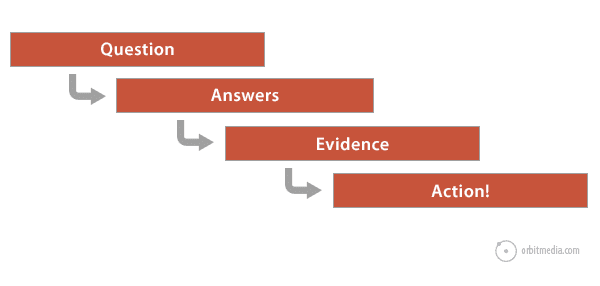The Content Marketing Program: Combining Creativity, Technology, Art & Science
Finding My Path
It was 1999 — an excellent time to be an IT recruiter. Companies were hiring fast to keep up with the tech bubble and everyone thought the world might collapse because of something called "Y2K." There was a lot of hiring going on and recruiting was lucrative.
But I was getting bored. I was talking about projects all day, but I never got to work on anything myself. I wanted to do something more creative.
I was already working on side projects at night, making interactive comic books with a friend. It was a silly business idea, but it was a chance to combine creativity and technology, art, and science. I was hooked.
When interactive comic books didn't become the next big thing, I had to find another place to do something creative online. So I quit my day job and started building websites with my buddy, Barrett Lombardo. That was in January of 2000. By spring of 2001, we'd started Orbit Media. And we never looked back.
Content Trends
My work is content — at least most of it is. And content has definitely changed over the last few years. Here are a few of the trends I'm watching and tactics I'm embracing for now...
Bigger Content
People are publishing longer articles than before. It's a response to the volume of content being published. The idea is to go bigger than the competitors by publishing the most detailed, research-driven article on the topic.
Private Social Networks
A lot of the content marketers I know are a bit less active in the public side of social media and a bit more active within private networks. I'm seeing a lot of activity in private Slack groups of content marketers. I know a lot of people connecting and collaborating in Facebook groups and in mastermind sessions.
Podcasting
It was a sleepy little channel for marketers for many years. But there seems to be a mini-explosion of interest in marketing podcasts. A lot of us are experimenting with audio. We'll see if this trends lasts.
These have been big evolutions for me, but I'm not suggesting that these tactics will work for everyone!
Giving Advice Through Your Content Marketing Program
Our content marketing program is the key to our growth. We don't buy ads, so we use content to grow brand awareness and attention. We use several formats for content (e.g., articles, videos, podcasts, and live events), but it's all content and it's all organic.
Here is a view of our traffic growth. You can see there has been a 937% increase in pageviews over the last five years.
Of course, this would be impossible without content. So you need a platform for your content marketing program.
You need Uberflip, or some other way to publish, manage and optimize your content experiences. Fill it with your best advice and the advice of others.
Content is a Contest to Be the Most Generous Brand Online
Content is why people visit websites! That traffic is brand awareness, but it also drives the subscribers, followers and links that power your marketing. Those actions are the forces behind your email, social, and search efforts. And that's how you fill your funnel.
But traffic isn't leads. All the visitors in the world don't create demand unless the visitor converts.
Conversation Rates Reflect How Well You’re Listening
Most marketers have a solid understanding of how content builds an audience. The basics of search, social, and email marketing are understood and smart content marketers are growing their traffic consistently. But there is a blind spot that I worry about: conversion rate optimization.
Ironically, content marketers have a huge opportunity to improve conversion rates. Here are two reasons:
-
They are expert listeners and understand their audience.
-
Content changes to conversion pages pay off over the long haul. Sales pages have longer lifespans than blog posts.
So before you write another article, go look at the products and services pages on your site. Does the page answer the top questions of this visitor? If not, you have an amazing opportunity to improve your results through content. Here's the framework:

Content that answers those top questions will increase the conversion rate. Every unanswered question is a weakness in the lead generation process. Once you've answered these questions, you need to support each of those answers with a bit of evidence. Finally, add clear compelling calls-to-action for every page.
Once you've done this, you'll get more value from every effort to drive traffic.
Slow Down Your Readers with Formatting
Articles either align with how visitors consume digital content or they don't. Be realistic. Your readers are scanners. And there's only one way to slow them down: formatting. Here's what to do.
-
Write short paragraphs. Whitespace is important for both design and writing. Never write a paragraph longer than 3-4 lines.
-
Use subheads, bullet lists and numbered lists. Never miss a chance to add structure.
-
Add multiple images. Make sure there is something of visual interest at every scroll depth. Never let your visitors hit a wall of text.
These are make or break aspects of digital content. If you do everything else well, but fail to add in these elements, you'll lose your readers. Formatting is critical. Naturally, we've used each of these tactics throughout this piece. That may be why you're still reading!

